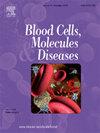Hereditary disorders of ineffective erythropoiesis
IF 1.7
4区 医学
Q3 HEMATOLOGY
引用次数: 0
Abstract
Under steady state conditions, humans must produce ∼2 million red blood cells per second to sustain normal red blood cell counts and hemoglobin levels. Ineffective erythropoiesis, also termed dyserythropoiesis, is a process by which erythroid precursors die or fail to efficiently differentiate in the bone marrow. Ineffective erythropoiesis is characterized by expanded bone marrow erythropoiesis and increased erythroferrone production by bone marrow erythroblasts, with the latter resulting in reduced hepcidin production and increased iron absorption. Ineffective erythropoiesis may result from acquired and congenital conditions. Inherited causes of ineffective erythropoiesis include β-thalassemia, sideroblastic anemias, pyruvate kinase deficiency, and congenital dyserythropoietic anemias. This manuscript reviews the definition and evidence for ineffective erythropoiesis and describes the most common hereditary disorders of dyserythropoiesis.
无效红细胞生成的遗传性疾病
在稳态条件下,人类每秒必须产生约200万个红细胞才能维持正常的红细胞计数和血红蛋白水平。无效红细胞生成,也称为红细胞生成不良,是红细胞前体在骨髓中死亡或不能有效分化的过程。无效的红细胞生成的特点是骨髓红细胞生成扩增和骨髓红细胞生成红细胞铁素增加,后者导致hepcidin生成减少和铁吸收增加。无效的红细胞生成可由后天和先天条件引起。无效红细胞生成的遗传原因包括β-地中海贫血、铁母细胞贫血、丙酮酸激酶缺乏和先天性促红细胞生成性贫血。这篇文章回顾了无效红细胞生成的定义和证据,并描述了最常见的遗传性红细胞生成疾病。
本文章由计算机程序翻译,如有差异,请以英文原文为准。
求助全文
约1分钟内获得全文
求助全文
来源期刊
CiteScore
4.90
自引率
0.00%
发文量
42
审稿时长
14 days
期刊介绍:
Blood Cells, Molecules & Diseases emphasizes not only blood cells, but also covers the molecular basis of hematologic disease and studies of the diseases themselves. This is an invaluable resource to all those interested in the study of hematology, cell biology, immunology, and human genetics.

 求助内容:
求助内容: 应助结果提醒方式:
应助结果提醒方式:


